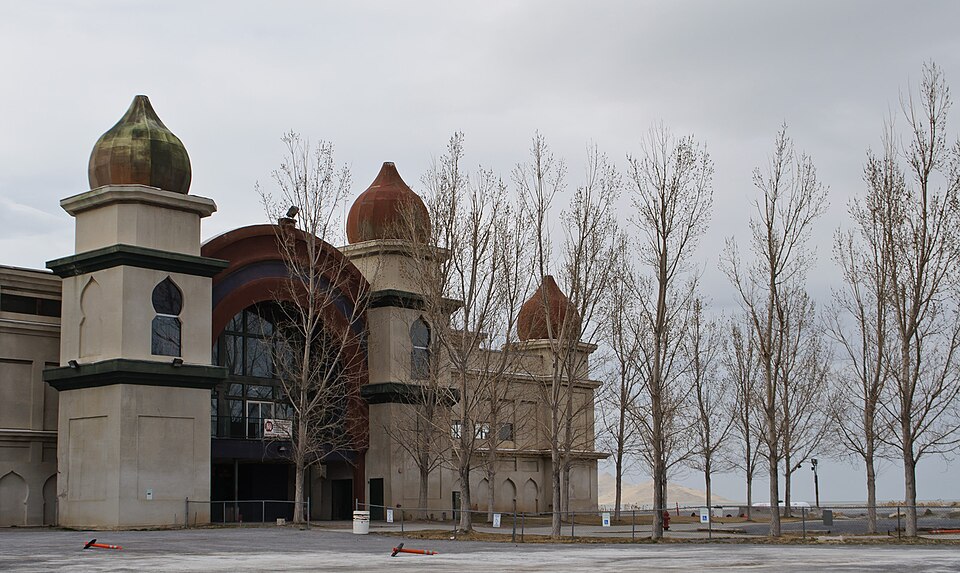Standing on the southern shore of the Great Salt Lake is one of Utah’s most iconic landmarks—the Great Saltair. Part music venue, part historical relic, and part legend, Saltair has lived many lives since it first opened in the late 19th century. Its story weaves together glamorous beginnings, devastating fires, floods, and a lingering aura of mystery that keeps both travelers and ghost hunters intrigued. Whether you’re a history buff, an adventurer, or someone chasing whispers of the paranormal, the Great Saltair offers a journey into the past unlike any other.
The History
The Birth of Saltair (1893)
The original Saltair was built in 1893, envisioned as the “Coney Island of the West.” Sponsored by the Church of Jesus Christ of Latter-day Saints, it was designed as a wholesome, family-friendly resort where Utahns could gather by the unusual waters of the Great Salt Lake. The architecture was nothing short of grand—exotic Moorish-inspired towers, sweeping dance floors, and pavilions that shimmered against the desert backdrop.
Trains brought thousands of visitors from Salt Lake City directly to its doors.
Guests swam in the buoyant saltwater, danced to live orchestras, and enjoyed picnics with the lake as their backdrop. In its heyday, the resort could host over 10,000 people at once. Saltair quickly became not just a place of leisure, but a cultural landmark in Utah.
Fires and Rebirth
Like many historic resorts, tragedy struck more than once. In 1925, a massive fire destroyed much of the original structure. Rather than giving up, developers rebuilt a new version of Saltair in 1926, even larger and more ambitious.
This second Saltair featured a roller coaster, concessions, and an enormous dance hall that attracted big-name bands of the Jazz Age. Once again, it stood as the pride of Utah’s recreation scene.
But nature had other plans. The Great Depression, coupled with fluctuating water levels of the lake, made it increasingly difficult to maintain. Attendance waned, and by the mid-20th century, the once-thriving resort was fading.
Saltair III: The Modern Era
In the 1980s, a new structure—dubbed “Saltair III”—was built. Though smaller and less ornate than its predecessors, it carried the spirit of the original resort. Today, this version of the Great Saltair functions as a concert venue, hosting touring musicians and festivals. From rock bands to electronic raves, its cavernous interior pulses with energy, while outside the lake and desert sunsets remind visitors of its timeless setting.
Yet for many, the Great Saltair is more than just a venue. It is a place where echoes of the past seem to linger, and some believe not all of its history has been left behind.
The Haunt
With over a century of fires, floods, and forgotten memories, it’s no surprise that the Great Saltair has developed a reputation for being haunted. Visitors, staff, and paranormal investigators alike report strange occurrences within its walls.
Phantom Footsteps and Voices
One of the most common claims involves the sound of footsteps echoing across the empty halls late at night. Security staff have shared stories of doors slamming shut and voices murmuring when no one else is inside. Some speculate these sounds are the residual energy of the thousands who once danced here in the golden era of Saltair.
The Drowned and the Lost
The waters of the Great Salt Lake have their own chilling legacy. Over the decades, there were reports of accidents and drownings near Saltair’s piers.
While many swimmers enjoyed the strange buoyancy of the lake, others were less fortunate. Paranormal enthusiasts believe that some of these restless spirits may still linger along the shoreline, drawn back to the last place they saw.
A Feeling of Being Watched
Numerous visitors report an uncanny sensation of being watched while exploring Saltair’s shadowy corners. Paranormal teams who have investigated the site note unusual electromagnetic readings and sudden temperature drops. For some, these sensations are unnerving; for others, they’re an irresistible invitation to dig deeper.
Concerts and Ghosts
Interestingly, some musicians and concert-goers have claimed odd experiences during events. Shadows moving in the rafters, equipment behaving strangely, and lights flickering without explanation all add to Saltair’s haunted mystique. Even in its modern incarnation, the past seems to press in on the present.
Why Ghost Hunters Should Visit
For paranormal investigators, the Great Saltair is a goldmine of potential activity.
It combines layers of rich history, tragic events, and modern accessibility—making it one of Utah’s most compelling haunted locations. The mix of abandoned areas, eerie acoustics, and the desolate landscape of the Great Salt Lake itself provides the perfect backdrop for a chilling night of exploration.
Whether you’re setting up EVP recorders, snapping photos in search of anomalies, or simply soaking in the atmospheric silence after a concert, Saltair delivers an unforgettable experience. Its blend of beauty and eeriness makes it a must-stop destination for ghost hunters traveling through the American West.
Conclusion
The Great Saltair is more than just a concert hall—it’s a living relic of Utah’s past, a testament to resilience, and a place where history and legend intertwine. From its glamorous origins as a lakeside resort to its mysterious present-day reputation, Saltair continues to captivate and inspire. For ghost hunters, it offers a rare opportunity: the chance to connect with echoes of the past while standing at the edge of one of the world’s most unique natural wonders.
So the next time you find yourself near the Great Salt Lake, step inside the Great Saltair. You may come for the music, the history, or the sunset views—but you just might leave with a ghost story of your own.

